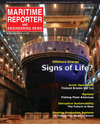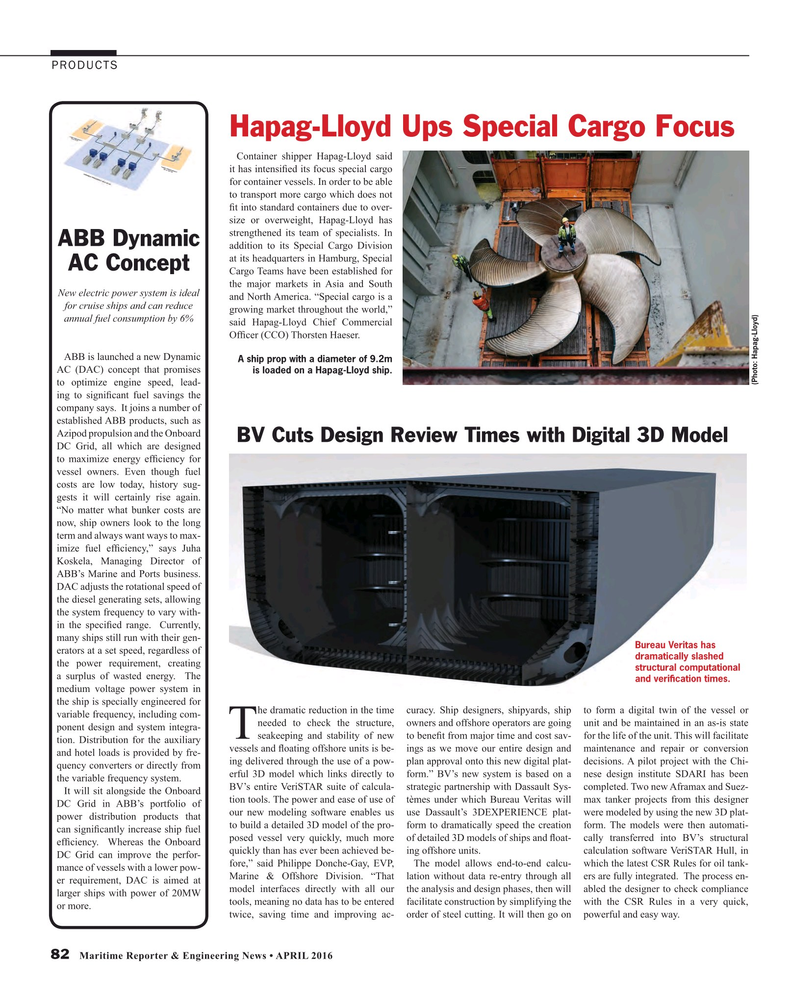
Page 82: of Maritime Reporter Magazine (April 2016)
The Offshore Annual
Read this page in Pdf, Flash or Html5 edition of April 2016 Maritime Reporter Magazine
PRODUCTS
Hapag-Lloyd Ups Special Cargo Focus
Container shipper Hapag-Lloyd said it has intensi? ed its focus special cargo for container vessels. In order to be able to transport more cargo which does not ? t into standard containers due to over- size or overweight, Hapag-Lloyd has strengthened its team of specialists. In
ABB Dynamic addition to its Special Cargo Division at its headquarters in Hamburg, Special
AC Concept
Cargo Teams have been established for the major markets in Asia and South
New electric power system is ideal and North America. “Special cargo is a for cruise ships and can reduce growing market throughout the world,” annual fuel consumption by 6% said Hapag-Lloyd Chief Commercial
Of? cer (CCO) Thorsten Haeser.
ABB is launched a new Dynamic
A ship prop with a diameter of 9.2m
AC (DAC) concept that promises is loaded on a Hapag-Lloyd ship.
(Photo: Hapag-Lloyd) to optimize engine speed, lead- ing to signi? cant fuel savings the company says. It joins a number of established ABB products, such as
Azipod propulsion and the Onboard
BV Cuts Design Review Times with Digital 3D Model
DC Grid, all which are designed to maximize energy ef? ciency for vessel owners. Even though fuel costs are low today, history sug- gests it will certainly rise again. “No matter what bunker costs are now, ship owners look to the long term and always want ways to max- imize fuel ef? ciency,” says Juha
Koskela, Managing Director of
ABB’s Marine and Ports business.
DAC adjusts the rotational speed of the diesel generating sets, allowing the system frequency to vary with- in the speci? ed range. Currently, many ships still run with their gen-
Bureau Veritas has erators at a set speed, regardless of dramatically slashed the power requirement, creating structural computational a surplus of wasted energy. The and veri? cation times.
medium voltage power system in the ship is specially engineered for he dramatic reduction in the time curacy. Ship designers, shipyards, ship to form a digital twin of the vessel or variable frequency, including com- needed to check the structure, owners and offshore operators are going unit and be maintained in an as-is state ponent design and system integra-
Tseakeeping and stability of new to bene? t from major time and cost sav- for the life of the unit. This will facilitate tion. Distribution for the auxiliary vessels and ? oating offshore units is be- ings as we move our entire design and maintenance and repair or conversion and hotel loads is provided by fre- ing delivered through the use of a pow- plan approval onto this new digital plat- decisions. A pilot project with the Chi- quency converters or directly from erful 3D model which links directly to form.” BV’s new system is based on a nese design institute SDARI has been the variable frequency system.
BV’s entire VeriSTAR suite of calcula- strategic partnership with Dassault Sys- completed. Two new Aframax and Suez-
It will sit alongside the Onboard tion tools. The power and ease of use of tèmes under which Bureau Veritas will max tanker projects from this designer
DC Grid in ABB’s portfolio of our new modeling software enables us use Dassault’s 3DEXPERIENCE plat- were modeled by using the new 3D plat- power distribution products that to build a detailed 3D model of the pro- form to dramatically speed the creation form. The models were then automati- can signi? cantly increase ship fuel posed vessel very quickly, much more of detailed 3D models of ships and ? oat- cally transferred into BV’s structural ef? ciency. Whereas the Onboard quickly than has ever been achieved be- ing offshore units. calculation software VeriSTAR Hull, in
DC Grid can improve the perfor- fore,” said Philippe Donche-Gay, EVP, The model allows end-to-end calcu- which the latest CSR Rules for oil tank- mance of vessels with a lower pow-
Marine & Offshore Division. “That lation without data re-entry through all ers are fully integrated. The process en- er requirement, DAC is aimed at model interfaces directly with all our the analysis and design phases, then will abled the designer to check compliance larger ships with power of 20MW tools, meaning no data has to be entered facilitate construction by simplifying the with the CSR Rules in a very quick, or more.
twice, saving time and improving ac- order of steel cutting. It will then go on powerful and easy way.
82 Maritime Reporter & Engineering News • APRIL 2016
MR #4 (82-89).indd 82 4/8/2016 12:26:28 PM

 81
81

 83
83
